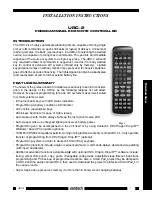
SARA-G3 and SARA-U2 series - System Integration Manual
UBX-13000995 - R08
Objective Specification
System description
Page 44 of 188
RTS signal behavior
The hardware flow control input (
RTS
line) is set by default to the OFF state (high level) at UART initialization.
The module then holds the
RTS
line in the OFF state if the line is not activated by the DTE: an active pull-up is
enabled inside the module on the
RTS
input.
If the HW flow control is enabled, as it is by default, the module monitors the
RTS
line to detect permission from
the DTE to send data to the DTE itself. If the
RTS
line is set to the OFF state, any on-going data transmission
from the module is interrupted until the subsequent
RTS
line change to the ON state.
The DTE must still be able to accept a certain number of characters after the
RTS
line is set to the OFF
state: the module guarantees the transmission interruption within two characters from
RTS
state change.
Module behavior according to
RTS
hardware flow control status can be configured by AT commands (for more
details, see
u-blox AT Commands Manual
[3], AT&K, AT\Q, AT+IFC command descriptions).
If AT+UPSV=2 is set and HW flow control is disabled, the module monitors the
RTS
line to manage the power
saving configuration:
When an OFF-to-ON transition occurs on the
RTS
input line, the UART is enabled and the module wakes up
to active-mode: after ~20 ms from the OFF-to-ON transition the UART / module wake up is completed and
data can be received without loss. The module cannot enter the low power idle-mode and the UART is kept
enabled as long as the
RTS
input line is held in the ON state
If the
RTS
input line is set to the OFF state by the DTE, the UART is disabled (held in low power mode) and
the module automatically enters low power idle-mode whenever possible
For more details, see section 1.9.1.4 and
[3], AT+UPSV command.
DSR signal behavior
If AT&S1 is set, as it is by default, the
DSR
module output line is set by default to the OFF state (high level) at
UART initialization. The
DSR
line is then set to the OFF state when the module is in command mode or in online
command mode and is set to the ON state when the module is in data mode (see the
u-blox AT Commands
Manual
[3] for the definition of the interface data mode, command mode and online command mode).
If AT&S0 is set, the
DSR
module output line is set by default to the ON state (low level) at UART initialization and
is then always held in the ON state.
DTR signal behavior
The
DTR
module input line is set by default to the OFF state (high level) at UART initialization. The module then
holds the
DTR
line in the OFF state if the line is not activated by the DTE: an active pull-up is enabled inside the
module on the
DTR
input.
Module behavior according to
DTR
status can be changed by AT command (for more details, see
u-blox AT
Commands Manual
[3], AT&D command description).
If AT+UPSV=3 is set, the
DTR
line is monitored by the module to manage the power saving configuration:
When an OFF-to-ON transition occurs on the
DTR
input line, the UART is enabled and the module wakes up
to active-mode: after ~20 ms from the OFF-to-ON transition the UART / module wake up is completed and
data can be received without loss. The module cannot enter the low power idle-mode and the UART is kept
enabled as long as the
DTR
input line is held in the ON state
If the
DTR
input line is set to the OFF state by the DTE, the UART is disabled (held in low power mode) and
the module automatically enters low power idle-mode whenever possible
For more details, see section 1.9.1.4 and
[3], AT+UPSV command.
AT+UPSV=3 power saving configuration control by the
DTR
input is not supported by SARA-G3 modules.
















































